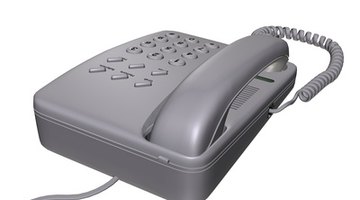Symptoms of a Faulty Wall Telephone Jack
Table of Contents
Because it receives more mechanical and environmental stresses than other system component, the wall telephone jack is a common failure point of a home telephone network. Pulled telephone cords can stress the individual contacts inside the jack and result in poor electrical connections.

In addition, the wall jack is exposed to heat and moisture from the house, as well as accidental physical damage from phone users. Wall phone jack damage has a number of common symptoms.
Dial tone intermittent or absent
A nonexistent or intermittent dial tone can indicate a defective wall jack. If swapping the cord between the phone and the wall jack does not cure this problem, the wall jack may be at fault. The problem may either be a worn contact in the wall jack or a broken wire at the rear screw terminals of the jack.
Crackling Noise
Intermittent electrical connections in a phone wiring system can cause noise and "crackle" on a telephone line. Jiggle the wires between the phone and the wall; if the noise increases, either the phone cord or the wall jack is defective. If you swap the phone cord and the noise does not diminish, the wall jack is likely at fault.
Dropped Calls
If you occasionally drop calls, the culprit may be an intermittent connection in your wall phone jack. The telephone system is designed to terminate calls in the event of an interruption of a connection with an active phone. A defective or worn wall phone jack can cause this break in the phone circuit, resulting in a dropped call.
Crosstalk
Some wall phone jacks are wired for multiple phone lines. If you can hear conversations or noise from a fax or modem on your phone line, the wall outlet may be allowing cross talk from one phone line to interfere with the other—an uncommon, but not impossible, occurrence.
Other Telephones and Devices

Many of the symptoms of a defective wall phone jack could also result from a malfunctioning phone or telephonic device elsewhere in your house. If you unplug all other telephones and devices with a phone connection—including modems, fax machines, cable television boxes—and the problem does not go away, the phone jack is a likely suspect.
References
- "The Complete Guide to Home Wiring"; Black and Decker; 2005
Writer Bio
Andrew Hazleton has been writing on a freelance basis for more than 20 years, and his work has appeared in national, regional and in-house publications. His work has appeared in "Sports Illustrated," "IEEE Spectrum," "Popular Photography" and several newspapers. Hazleton has a Bachelor of Science in engineering from Lehigh University and a master's degree in management from Pepperdine University.
Photo Credits
- telephone image by Goran Bogicevic from Fotolia.com
- telephone image by Goran Bogicevic from Fotolia.com
- telephone image by Francois du Plessis from Fotolia.com
More Articles



